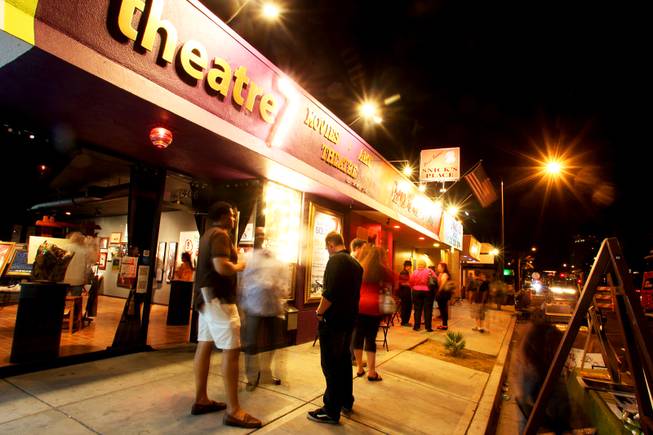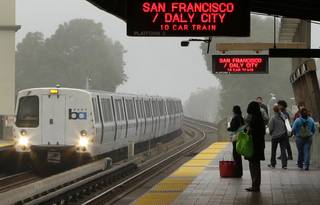
First Friday, a monthly celebration of art, in the downtown Arts District.
Sunday, Jan. 17, 2016 | 11:33 a.m.
Related Content
- How does Southern Nevada pay for a new mass transit system?
- Light rail: The future of transportation in Las Vegas?
- How does a plan like this come to be? Who is responsible
- Rail projects in other cities: How’d they do it?
- Getting Southern Nevada’s future on the right track
- How mass transit will affect Southern Nevada business
- How mass transit will affect Southern Nevada tourism
- How mass transit will affect Southern Nevada tourism
- How mass transit will affect downtown Las Vegas
- How mass transit will affect North Las Vegas
- How mass transit will affect sports in Southern Nevada
- How mass transit will affect Southern Nevada’s people and lifestyle
- A local’s take: The evolution of transportation in Las Vegas
- Editorial: Why Southern Nevada needs mass transit
- The Sun's light rail coverage
A look into the future: Residents of downtown Las Vegas ride their bikes to the closest light rail station. They dismount, pick up their bikes and store them on the train. There no longer is a need for a car. Getting around town becomes lively — sometimes too lively when the train picks up late-night partiers on the Strip. Co-workers and friends run into each other. Strangers stop for conversations. Light rail connects parts of the city that never before were linked.
Tourists take light rail to the Strip. A UNLV student takes the train from campus to North Las Vegas for a class project. A resident commutes to his job at Town Square.
There is less traffic in the core area of the valley — around the Strip and McCarran International Airport. Mobility is vastly improved.
Vibe
Portland has the Pearl District, and Austin has 6th Street. Millennials crowd these areas for their vibe — the hipster bars, chic coffee shops and intimate music venues. Las Vegas has many of the same amenities, but they largely are unconnected. Some are downtown. Some are in the Arts District. Some are on the Strip. So spread out are they that visitors often are surprised so many options exist. A light rail system could connect them and allow visitors and residents more mobility. It’s easy to get trapped in the valley. Visitors don’t have to leave the Strip, let alone their hotel. Residents don’t have to leave their neighborhoods. Light rail would give people more options to move. Visitors seeking out neighborhood bars and coffee shops could take a train downtown, while locals could access the Strip without weaving through congestion and crowds.
Quality of life
Las Vegas is ruled by cars. Most people here drive to work, and many find themselves grinding their teeth through traffic. A light rail system could cut down on the miles people drive and the time they spend in their cars. A well-planned transit system could eliminate the frustration of having to navigate some of the city’s densest areas. Moreover, in vehicles, people have little opportunity to interact with others, except perhaps to express their frustration with another driver. Light rail could connect people who otherwise would not interact in a valley that is sprawling and largely stratified into discrete communities. Development of stations also could create clusters and give areas a more discernible identity.
Environment
Working in tandem with taxis, Uber and Lyft, a light rail system could take a significant number of cars off the road, reducing energy use and greenhouse gas emissions. In 2014, drivers in Las Vegas traveled about 25 million miles every day on freeways, according to the Texas A&M Transportation Institute. Light rail could reduce that number. As municipalities and the state rely more on renewable energy and focus on sustainability, an operable light rail system could further cement and enhance Nevada’s commitment to a green future. Light rail also could encourage healthier habits among residents, such as biking to and from a rail station.
Housing
In downtown Las Vegas, there is high-end housing in luxury apartment buildings, such as the Juhl and the Ogden, but a dearth of mid-range housing. Proponents of a light rail system say its development could stimulate the creation of more affordable housing.
But because rents tend to rise around light rail lines, it would require a concerted effort by city officials.
In neighborhoods that have developed new public transportation, the vast majority — 74 percent — saw rising rent, according to a study from the Dukakis Center for Urban and Regional Policy at Northeastern University. Cities such as Charlotte, N.C., and Denver combated potential problems of pricing out existing residents by buying land around transit stations to ensure affordable housing. In 2015, Los Angeles’ metro agency embarked on a similar course, evaluating land around its rail stations that can be set aside for affordable housing.
Density
Some of the passengers on your train car are wearing work uniforms and are on their way to the job. Some are in casual clothes, running errands. Their common denominator: They walked from home to the station. Welcome to one of the possibilities of a light rail system — that it could improve mobility and might prompt residents to rely less on their cars and instead move to locations along the line. The result is that density would increase along rail corridors. That scenario isn’t inevitable, mind you. A study of Census data from The Atlantic’s Citylab showed that in five of six cities that adopted light rail in the 1980s, the number of regional workers taking the system decreased over time and the city’s proportion of urbanized area did not increase. But that doesn’t mean light rail wouldn’t help contain sprawl and boost density in Las Vegas. The Citylab study said a light rail system combined with efforts by local stakeholders to encourage development and boost ridership could yield results.
Techies and Millennials
As head of Downtown Project Ventures, Mark Rowland helps shape and execute the long-term vision of Zappos CEO Tony Hsieh’s $350 million investment in downtown Las Vegas, entering its fifth year. A large part of that goal is creating a tech hub downtown. To do that, the Downtown Project needs to recruit tech talent, which leaders have struggled to do. With a light rail line that provided service to North Las Vegas, the site of the new Faraday Future car plant, Rowland thinks the area could see an infusion of tech talent.
“That’s going to be a huge jolt for the injection of talent to Las Vegas,” he said.
Millennials born between 1982 and 2003 tend to be multimodal, switching between types of transportation depending on their needs. A light rail system could give them an additional — and welcome — option.
University students, many of whom don’t own cars, also could benefit from light rail, living or socializing in diverse parts of the valley, without needing a vehicle.
Workers on the Strip
Light rail could be most beneficial to workers on the Strip, especially those with multiple shifts. Strip casinos employ about 100,000.
If workers already live near the corridor, light rail could cut down on Strip traffic.


Join the Discussion:
Check this out for a full explanation of our conversion to the LiveFyre commenting system and instructions on how to sign up for an account.
Full comments policy